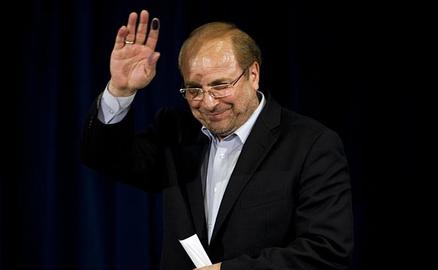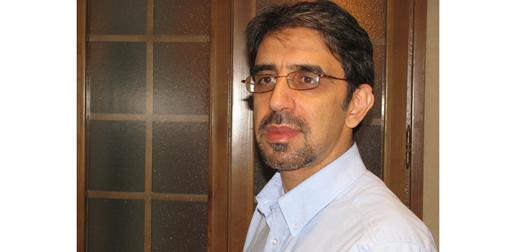A renewed battle has broken out between President Rouhani’s administration and the judiciary over the continued house arrest of the Green Movement leaders.
Mir Hossein Mousavi, Mehdi Karroubi and Zahra Rahnavard have been under house arrest for more than five years, after they led the outcry against the results of 2009’s disputed presidential election, when Mahmoud Ahmadinejad secured a second term.
During President Rouhani’s campaign for re-election — and in his bid for election in 2013 — he promised to end their house arrest. But, on May 29, the head of Iran’s judiciary, Ayatollah Sadegh Amoli Larijani, harshly criticized the president, saying he had no authority to make such promises. Larijani also warned the media to practice restraint, a barely veiled threat that there would be repercussions if the media reported too liberally on the issue.
So how likely is it that the Green Movement leaders will be freed, and who can make it happen? And what are the political ramifications?
1. Who had the final word on the house arrests?
On December 27, 2009, a series of protests against the official results of the 2009 presidential election rocked Tehran and other Iranian cities. This followed a string of protests immediately following the June election, which led to thousands of arrests and to the deaths of dozens of people. The December unrest became known as the Ashura protests because they coincided with the Shia holy day of Ashura. The demonstrations turned deadly and violent when the security forces attacked the protesters.
Shortly thereafter, General Esmail Ahmadi Moghadam, commander of the national police, met with the Supreme Leader Ayatollah Khamenei to ask for his instructions. “I said a number of people who were involved in this sedition must be arrested,” recounted the general in an interview with the prominent conservative newspaper Kayhan on December 25, 2012. He said Khamenei told him to verify the list of people and bring it to him to get permission for the arrests. “We did that and presented him with a list of 40 names,” said Ahmadi Moghadam. He said the supreme leader told him he would take care of Mousavi, Karroubi and other reformist leaders, adding: “The police, the security forces and the judiciary have done their duties but there are higher considerations at work...”
Khamenei then proceeded to illustrate his intention, as he is fond of doing, by comparing the situation to events in early Islam. In this case, he used the example of Imam Ali, the first Shia Imam, and his treatment of Talhah and Zubayr, two companions of Prophet Mohammad who pledged loyalty to Ali when he became the caliph but later turned against him. Imam Ali decided to treat them with moderation and then, if moderation failed, with decisive force.
The ayatollah had used the same analogy earlier, in his Friday Prayer sermon on September 11, 2009. “Commander of the Faithful [Imam Ali] treated Talhah and Zubayr well,” he announced, in a not-so-subtle warning to Mousavi and others, “but if moderation does not work it is time for decisive action in the manner of Ali.”
On January 29, 2012, conservative principlist politician Mohammad-Reza Bahonar told Fars News Agency that Ayatollah Khamenei agreed to the house arrests. He was deputy speaker of Iran’s parliament at the time. And in early 2013, Gholam Ali Haddad-Adel, a former speaker of parliament, said that the Green Movement leaders were put under house arrest rather than before a trial because “the leader’s view was to take it easy [on them] as much as possible.”
These anecdotes show that when it came to dealing with the leaders of the Green Movement, the supreme leader was not only following a historical precedent, he was also at the center of decision-making. As he himself claimed in a meeting with parliamentarians in the summer of 2013, it was his “guidance” that assured the leaders of the Green Movement were treated “kind-heartedly.”
2. How were the house arrests enforced?
“What the judiciary can do and I believe is thinking about,” said Ayatollah Jannati, Chairman of the Guardian Council in his Friday Prayers sermon on February 18, 2011, “is to completely cut off any communication between them and the people. The doors to their homes must be closed, their movements must be limited, they must not be able to send or receive messages, their phones and their internet must be cut off — and they must be imprisoned inside their homes.”
A day before this, Judiciary Chief Sadegh Larijani announced a media ban on the “leaders of the Sedition” — the term ultra-conservatives coined when referring to the Green Movement leaders. And on March 2, 2011, quoting security sources, Kayhan newspaper reported that the leaders had been under house arrests since February 15, 2011 — the day after Mousavi and Karroubi led a march in support of the people of Tunisia and Egypt during the so-called Arab Spring. “They announced that they wanted to create a revolution like those in Tunisia and Egypt,” said Saeed Jalili, hardliner politician and President Ahmadinejad’s Chief Nuclear Negotiator, in late 2014 at a gathering in Ferdowsi University in Mashhad. “These new seditions was what led to their house arrests.”
Later it was claimed that the High National Security Council (HNSC) took the decision to place the leaders under house arrest. But media reports published between early 2011 and early 2013 do not suggest any link between the house arrests and the HNSC. Ayatollah Jannati reported it, Sadegh Larijani put it into action and the supreme leader agreed with it.
3. So where does the High National Security Council come in?
In May 2013, Tehran’s mayor, Mohammad Bagher Ghalibaf — who was preparing to run as a presidential candidate — claimed that the house arrests had not actually been ordered by the supreme leader, but by the HNSC. Around the same time, Hassan Rouhani, who was also running for president, referred to the HNSC and its role. “The next president must create a consensus among the branches of government to end the house arrests,” he said. He even went so far as to promise that he would accomplish this within a year if elected.
Rouhani’s statements gave the role of the HNSC more prominence. But in September 2012, Ali Motahari, one of Tehran’s representatives, said that Ahmadinejad, as president of the Islamic Republic was also HNSC’s president, had “twice requested that the house arrests be lifted.” This begs the question: How can the HNSC have been in charge of the decision to keep the leaders under house arrest when its president had tried unsuccessfully to reverse this decision — not once, but twice? Motahari certainly had his doubts. In a letter to judiciary head Larijani on January 4, 2015, he called into question the logic that Ahmadinejad, as the council’s president, would have signed such a directive while at the same time appealing for the directive to be lifted on two occasions.
But as recently as February 6, 2016, the HNSC directive was being touted as the force behind the decision. “In February 2011, the secretariat of the High National Security Council passed directive no. 567, which put the least amount of restrictions on a few leaders of the Sedition and the culprits of street unrest,” an article in Kayhan newspaper claimed. But can the secretariat of the HNSC, which, according to President Rouhani does not even have the power to decide whether the media can publish photographs of former president Mohammad Khatami, have the power to decide about much more important decisions, namely, the house arrests of Mousavi, Karroubi and Rahnavard?
The answer is clear. At the time, Ayatollah Jannati and Sadegh Larijani and others were unwilling to allow the HNSC to make the decision. So they quickly pushed it through only the secretariat, bypassing the rest of the council members. The secretariat, which in theory only oversees bureaucratic measures and policy, was at that time run by Saeed Jalili. By doing this and securing Khamenei’s consent, they managed to secure a legal cover for themselves
4. President Rouhani vs. Sadegh Larijani: What’s it all about?
On September 11, 2013 Mohammad Taqi Karroubi, Mehdi Karroubi’s son, wrote on Facebook that the supreme leader had “agreed to refer the case of Mousavi and Karroubi to the Supreme National Security Council.” It is not clear who was dealing with the case before Khamenei agreed to refer it to the HNSC, but President Rouhani’s wish to ensure the council is the chief decision-maker in the case is understandable — while Sadegh Larijani, who represents Iran’s hardliners, wants to keep it within the domain of the judiciary. Larijani has repeatedly threatened that if the HNSC changes its decision, the judiciary will start making preparations to put the leaders of the Green Movement on trial.
The threat is Larijani’s attempt to discredit the HNSC, and by extension, the Rouhani administration. Even if Rouhani succeeds in gaining the approval of all council members to end the house arrests, Sadegh Larijani can then turn around and put Mousavi and Karroubi on trial. Then not only would the council’s decision not solve the problem, it would create a new one, unleashing a new round of political tensions and strife. It would also make the HNSC a laughingstock.
For Rouhani, lifting the house arrests is politically advantageous — he can say he has fulfilled his promise and gain more popularity and prestige. Larijani, on the other hand, would gain by putting Mousavi and Karroubi on trial, which would enhance his standing among the hardliners and show them that they can count on him.
5. What’s the update on the case?
At present, the reformists and moderates are tying their hopes to their affiliation with the High National Security Council, while the hardliners’ power sits with their links to the judiciary. Only one person can break this impasse and that person is, naturally, Ayatollah Khamenei.
If Khamenei approves a HNSC decision, the judiciary will have no option but to yield. But Khamenei is unwilling to step in. He refuses to end the saga without taking his personal revenge on Mousavi and Karroubi or, at the very least, commanding humble apologies from them. As Ali Motahari told reporters on November 5, 2016, “Since the leader’s view is that the house arrests should continue, other officials do not get involved.”
If the house arrests are lifted, and no apologies take place, this would be a blow to the personal and the political prestige of the Supreme Leader of the Islamic Republic. With this in mind, it’s easy to see the High National Security Council as nothing more than a straw man — at least when it comes to this issue. Voluntarily or otherwise, Sadegh Larijani has made himself and the HSNC into a shield for Khamenei. Ali Motahari put it very clearly on May 8: “Probably there are members of the High National Security Council who agree with lifting the house arrests, but they are mindful of the leader.” He then suggested an alternative to solve the problem: “I believe to get somewhere the authorities must talk to [Khamenei]. I don’t think that there is any other way at the present.”
So the saga of house arrests continue. Here we are talking about a grudge — a monumental grudge. And it is personal.
visit the accountability section
In this section of Iran Wire, you can contact the officials and launch your campaign for various problems



























comments